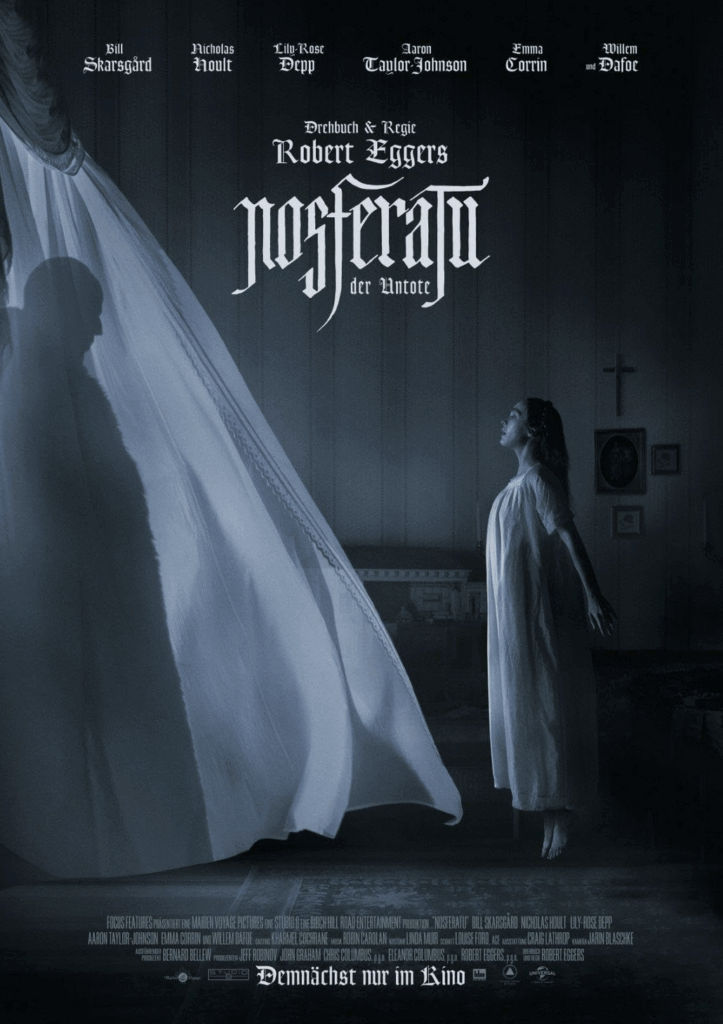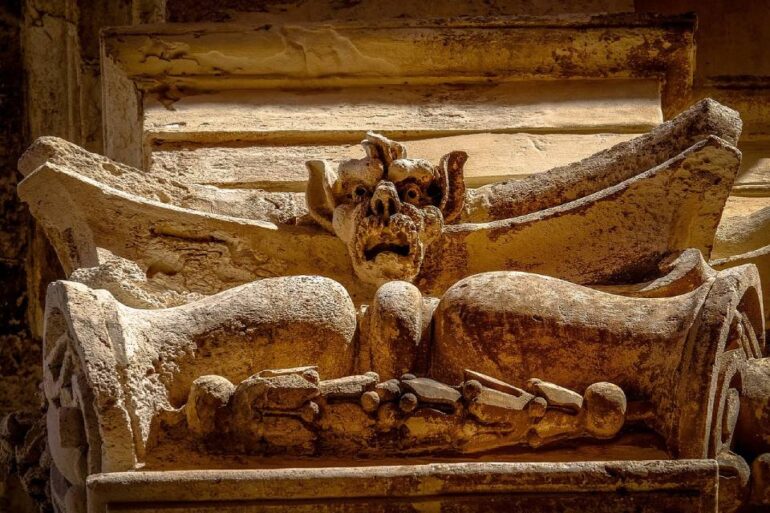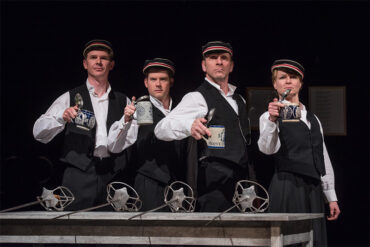Robert Eggers’ Nosferatu successfully remakes an iconic film while introducing fresh nuances, blending atmospheric world-building, a haunting visual style, and standout performances that add depth and emotional complexity to this reimagining of a classic tale.
By Sara Mirjavadi
Since its introduction to cinema goers in 1922, Nosferatu has been a big inspiration for all cinema enthusiasts, especially horror lovers. The iconic silent film, an unauthorized adaptation of Bram Stoker’s Dracula, faced legal challenges from Stoker’s estate, which objected to the unlicensed use of the story. One consequence was the filmmakers’ difficulty in settling on a title—eventually choosing Nosferatu, an archaic Romanian term often associated with vampires. In 2024, Robert Eggers’ rendition of Nosferatu once again brought the film into the spotlight, reaching a far wider audience. This macabre and chilling adaptation of FW Murnau’s 1922 silent film masterfully unsettles its viewers, evoking the same visceral torment that its characters endure when confronted by one of cinema’s most repugnant and unforgettable villains.
In this new adaptation, a young woman named Ellen becomes the object of a sinister and obsessive desire from Count Orlok, a vampire who thrives on the fear and destruction of others. Set against a gothic backdrop, Ellen’s own torment and vulnerability mirror the escalating danger as Orlok’s hunger for her grows, plunging her into a nightmarish world where love, fear, and death collide.
Portraying vampires as terrifying as they once were is no easy feat. Over the years with movies like Twilight and TV shows like The Vampire Diaries, or animated movies like Hotel Transylvania our perception of vampires has shifted, evolving into something far removed from their origins. Yet, Eggers has achieved something remarkable. His Nosferatu is a rotting, repugnant devil—devoid of remorse, driven only by his own insatiable hunger. He will stop at nothing, draining his victims of blood or cursing them with the plague. Because Ellen sees the truth: «We’re already dead».
The World Building
Eggers, who was immediately recognized as one of the brightest talents of his generation, is known for his meticulous attention to detail. However, what sets him apart isn’t the usual clickbait headlines about directors pushing actors to the brink with excessive takes or mind games on set. Instead, Eggers’ obsession with authenticity defines his work, delivering not just a breath of fresh air—but, in the case of this film, bloodcurdling screams—within a cinematic landscape that too often reduces screenwriting to mere content creation. Cinema, a multifaceted medium that strives to cast a mark on the heart and soul of its viewers, should not be compared to the fast-paced and attention-reducing logic of content creation that we often see in click bait oriented social media posts. Eggers, like any passionate artist, seems to understand this well. His work, although entertaining, also has artistic integrity. He knows that Nosferatu is a horror movie, and he is well aware that his audience wants to sit down and be frightened, however he does not do so by cheap tricks and jump scares. This is evident from the very first scene, where Lily Rose Depp’s character cries out for comfort. It is constructed in an immersive, eerie, sexual, and devious manner. The set-up and the foreshadowing capture the viewer so fully, that one can hardly think of anything else than the story Eggers is about to tell.
The costumes, makeup, lighting, mise-en-scène, and Count Orlok’s moustache and even the distant cries of birds are all meticulously designed to immerse the audience in the film’s time-period. Nosferatu is impressive on its own, but when one considers the level of thought and craftsmanship behind its writing and production, it becomes even more remarkable. Jarin Blaschke, Eggers’ longtime collaborator and cinematographer, joins forces with production designer Craig Lathrop and costume designer Linda Muir to create a gothic, suffocating atmosphere that engulfs the audience. Muir’s attention to detail can be seen in the meticulously German aesthetic they’ve conjured up in the movie: gloomy color scheme, thick, coarse textures of velvet and wool, and sharply structured silhouettes. The visuals are so immersive that it feels as if reaching out to the screen might summon Count Orlok himself. The suffocating symmetry, the naturally lit scenes, and the constant shadows all point to the presence of a horrid being lurking behind. All of this perfectly builds up to the scene where Thomas is met with the driverless carriage.
The Bride
Lily-Rose Depp’s performance is electric—like the crackling lightning that gave life to Frankenstein’s monster. In this case, her Ellen awakens something far more sinister: she electrifies Count Orlok’s unrelenting and destructive desire, pulling him from the shadows with a hunger that threatens to consume everything in its path.
In Eggers’ adaptation of Nosferatu, Ellen is given a fuller character arc, with her motivations and desires explored in much greater depth. At the beginning of the movie, Depp’s Ellen appears to have lived in quiet suffering, she begs for comfort from any celestial being, however what her call attracts is the vicious hold of Nosferatu. When we meet her again, that torment is no longer quiet. It is closing in, taking hold of her, and she is being consumed by it. At certain moments, Depp’s performance evokes the same vulnerability and rawness as Isabelle Adjani’s in Possession, pulling the audience into the depths of her character’s anguish. Her longing, innocence, and fragility stand in stark contrast to the monstrous force willing to destroy everything just to claim her as his so-called bride.

Nosferatu (2024)
Director: Robert Eggers
Count Orlok
Bill Skarsgård is not just unrecognizable as Count Orlok—Nosferatu himself—but he is utterly transformed. His animalistic breathing and agonizingly deep voice serve as constant warnings to stay away. With a mesmerizing display of craftsmanship, he seamlessly transitions from one iconic villain, Pennywise, to another, embodying Nosferatu with equal intensity and terror.
Through the mutual efforts of Eggers and Skarsgård, the legendary character of Nosferatu is truly resurrected. Unlike the Nosferatu of the original 1922 film, this Count Orlok is not a bald-headed, aristocratic figure with ghostly, spotless skin, but a festering wound of a creature—a rotting corpse whose grotesque mustache feels as startling and unsettling as the decay that eats away at him. While Skarsgård pays homage to the performances that came before him—and Eggers does the same throughout the film—they are not merely replicating the past; they are leaving their own indelible mark on the legend.






